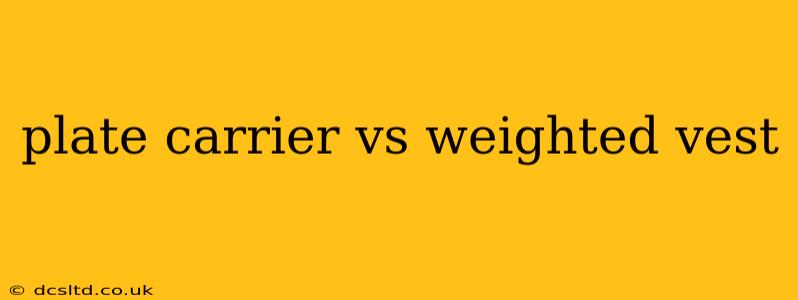Choosing between a plate carrier and a weighted vest depends heavily on your intended use. While both add weight for training purposes, their designs, functionalities, and applications differ significantly. This comprehensive guide will clarify the key distinctions, helping you make an informed decision based on your specific requirements.
What is a Plate Carrier?
A plate carrier is a tactical vest designed to hold ballistic plates, providing protection against bullets and shrapnel. While some use them for training, their primary function is body armor. They are typically constructed from durable materials like nylon or other high-tensile fabrics, featuring a modular design allowing for customization with pouches, hydration systems, and other accessories. The weight comes from the ballistic plates themselves, which can be ceramic, steel, or polyethylene.
Key Features of a Plate Carrier:
- Ballistic Protection: The main purpose; they are designed to stop bullets and shrapnel.
- Modular Design: Allows for customization with pouches and accessories.
- Adjustable Fit: Ensures a secure and comfortable fit for various body types.
- High Durability: Built to withstand harsh conditions and potential impact.
- Substantial Weight: The weight varies greatly depending on the type and size of plates used.
What is a Weighted Vest?
A weighted vest is a piece of fitness equipment designed to increase resistance during workouts. The weight is evenly distributed throughout the vest, typically using sand, iron shot, or weighted plates sewn into pockets. They are primarily used for improving strength, endurance, and overall fitness. Weighted vests are generally less expensive and more readily available than plate carriers.
Key Features of a Weighted Vest:
- Increased Resistance: Adds weight to enhance workouts, building strength and endurance.
- Even Weight Distribution: Promotes balanced movement and avoids undue strain on specific muscles.
- Variety of Weights: Available in various weights to adjust the intensity of workouts.
- Relatively Inexpensive: Generally more affordable than plate carriers.
- Lightweight Construction: Typically made from less durable materials than plate carriers.
Plate Carrier vs. Weighted Vest: A Detailed Comparison
| Feature | Plate Carrier | Weighted Vest |
|---|---|---|
| Primary Use | Ballistic protection, tactical training | Fitness training, strength and conditioning |
| Weight Source | Ballistic plates | Sand, iron shot, or weighted plates |
| Weight | Significantly heavier, varies greatly | Adjustable, generally lighter |
| Durability | Very high | Moderate |
| Cost | Significantly more expensive | Significantly less expensive |
| Protection | Provides ballistic protection | No ballistic protection |
| Versatility | High, modular design allows for customization | Low, primarily used for fitness training |
What are the advantages of using a plate carrier for training?
Using a plate carrier for training offers several advantages, but it's crucial to understand the risks. The significant weight simulates carrying heavy equipment in a tactical environment. This can build strength, endurance, and improve tactical movement. However, the uneven weight distribution and potential for injury if not used correctly must be considered. Proper training techniques and gradual weight increase are essential.
What are the disadvantages of using a weighted vest for tactical training?
While weighted vests are excellent for general fitness, they lack the specific benefits of a plate carrier for tactical training. The even weight distribution doesn't accurately replicate the feel and movement limitations of carrying ballistic plates. Additionally, a weighted vest doesn't offer any ballistic protection.
Which one is right for you?
The best choice depends entirely on your needs:
- For tactical training or situations requiring ballistic protection: Choose a plate carrier. Remember to prioritize safety and proper training techniques.
- For general fitness and strength training: A weighted vest is a more affordable and accessible option.
Ultimately, understanding the differences between a plate carrier and a weighted vest is crucial for making the right decision. Consider your specific needs, budget, and training goals before purchasing either piece of equipment. Remember, safety should always be your top priority.
